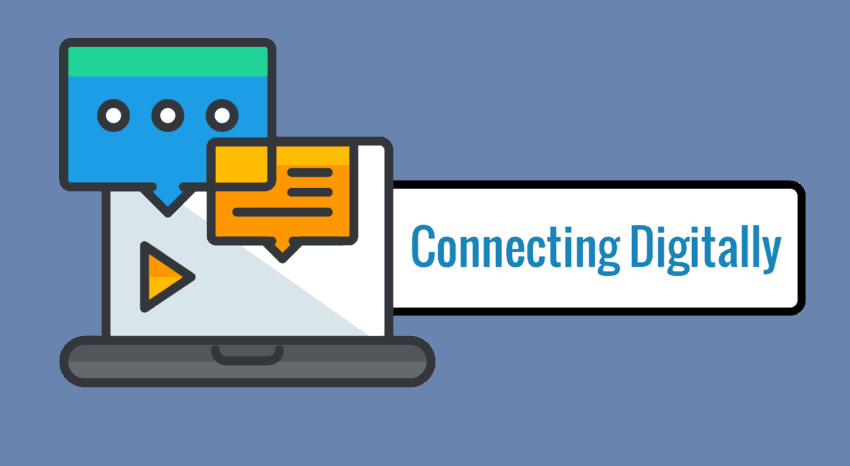Connecting with Customers Digitally

As dispersed companies grow and evolve, connecting with customers digitally becomes both easier and harder. Theoretically, we never have to miss a message because we receive notifications on our phones, laptops, and tablets. But we also use several different email accounts and communication platforms, which can become confusing and hard to track.
Communication can also be more strenuous when face-to-face contact isn’t possible. It is difficult to gauge interest or approval over phone or email compared to in-person meetings.
So how do you connect with your customers when face-to-face communication isn’t a possibility?
Limit your communication tools
When possible, limit the number of communication platforms you use to get in touch with your customers. If you define your preferred method of communication upfront and stick to it, the customer will expect that type of communication from you. Having an inconsistent approach for reaching out might confuse the customer.
Obviously, this won’t work for every contact. There are times you might need to reach out via phone, email, and messenger to finally get a response. But if you always start with the same method and expand from there, you’ll create a communication pattern that will make it easier to track responses–for both you and your customer.
Make confirmation part of communication
Make it a habit in your professional life to always repeat back to the customer what you think you know. The easiest way to bypass misunderstandings when connecting with customers is to ask, “Is this what you mean?”
This allows you to align with your customer and ensure both parties have an understanding. It also puts the ball back in their court, meaning they are responsible for clearing up miscommunications.
Use this in email, over the phone, chat channels — even in text messages if need be. Restate your customers’ own words so they can tell you if you’ve understood them. Customers will appreciate your initiative to strive for better communication.
Asking for confirmation goes hand-in-hand with avoiding assumptions. You might think something is safe to assume, but it’s even safer to ask the customer first.
Add meetings to a calendar
Don’t rely on a verbal agreement to set a meeting, always send them to a calendar. If you don’t do this, you can set yourself up for a misunderstanding. There is a chance one of you will get the wrong date or time, or forget the meeting completely if it’s too far in the future.
Sending the event to a calendar means you will each get a reminder before the meeting occurs. It also provides a second form of documentation that a meeting was scheduled. Creating a calendar event for a meeting shows a higher level of professionalism.
We’re all busy, and many professionals rely on their calendars to define their days. Respect the customer’s busy schedule by setting a meeting with a start-time and end-time. You don’t want a competitor to send a calendar invite for the same timeslot and miss out on that meeting.
Set an agenda
Every meeting has a purpose. If you don’t convey that purpose to the customer, they might not think you need to connect. Go a step beyond just mentioning what you’ll talk about, and create a clear agenda. Share it with your customer so you can go point-by-point and address any questions or concerns.
Creating an agenda keeps you organized and on-topic, but it also allows you to build flexibility into your meeting. Save time at the end to see if there is anything your customer needs to discuss. That will show them that you’re working to address their needs.
Generate regular website content
Nothing lets your customers know you appreciate them more than generating regular website content that is focused and meaningful. When you aren’t there to answer a question from a customer, you need to have confidence that your website is built to answer those questions.
Content needs to be available for both prospective and existing customers, and there should be a clear path guiding each of these groups to the right areas of the website. Even the converted customers who are contacted regularly need website engagement. They might be interested in problem solving on their own, learning about the features included in your product or service, or participating in webinars for continued training. Your customers are inevitably going to perform web searches for topics related to your product. When it’s your website that appears in the results every time, they are reaffirming their opinion of you as a thought leader. That’s why connecting with customers on your website can’t stop, no matter how long they’ve been your customer.
Regular website content also allows prospective customers to educate themselves before they get on the phone. All of a sudden, you’re dealing with an audience who understands their problem and the solution you offer. That takes the pressure off the sales team to constantly convert.
Connect Socially
Having a social presence is an absolute necessity when connecting with customers. While you don’t need to indulge in every social platform to start, building a Facebook, LinkedIn, or Twitter presence is a great first step. Facebook is still the most popular social media platform in the U.S., and your customers are on it. LinkedIn is valuable for establishing a professional network for B2B companies (though don’t think B2C can afford to live without it). And Twitter is where you can have a true, back-and-forth conversation with your audience.
Being available to your customers socially shows them you’re not stuck in the past. Many customers prefer to reach out via social platforms, sending either direct messages or posting publically. Implementing social media marketing gives your customers additional options for contacting you besides that email form on your website. It also increases your SEO reach, making you easier to find.
Just remember that building and maintaining social profiles are a responsibility, and an abandoned social media profile can have a negative impact. A profile that hasn’t been touched in months or years might (wrongly) signal to users that a company is out of business. It can also indicate a lack of interest in customer engagement. Therefore, you need to create a plan that is manageable for your marketing team.
Read our blog post on building a successful social media marketing campaign for more tips.
Conferences
Though face-to-face communication is not always possible, attending industry conferences gives you an opportunity to meet your customers in the flesh. You’re not making sales calls here, you’re having a true discussion about your product, other products in the room, and the industry as a whole. Put your best face forward and strive to do better than the booth next to you. Engage in panel discussions, after parties, dinners, luncheons, or host a session. In order for you to gain a loyal customer base, you need to use your time wisely at these conferences and tradeshows. Showing up is not enough. You need to make an impression.
There are many ways to connect with your customers, and there’s no right place to start. The important part is to create a complete and unified customer experience using the strengths of your sales and marketing teams.
Connecting with customers is easier when you have some help. DemandZEN is an experienced group of cold callers and marketers. We can help improve your customer engagement. Get started today.
You Might Also Enjoy These Posts
Demand Generation vs Lead Generation
B2B Appointment Setting Tips and Tricks that Always Work
Welcome To DemandZEN
DemandZEN specializes in Account-Based Demand Generation and solving the challenges around finding, engaging and converting target accounts into real opportunities for B2B Technology and Services companies.



